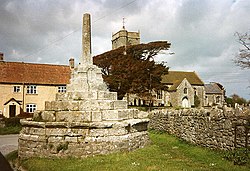Wick St Lawrence
| Wick St Lawrence | |
| Somerset | |
|---|---|
 Ancient cross and Church of St Lawrence | |
| Location | |
| Grid reference: | ST365655 |
| Location: | 51°23’6"N, 2°54’50"W |
| Data | |
| Population: | 1,331 (2011[1]) |
| Post town: | Weston-super-Mare |
| Postcode: | BS22 |
| Dialling code: | 01934 |
| Local Government | |
| Council: | North Somerset |
| Parliamentary constituency: |
Weston-super-Mare |
Wick St Lawrence is a parish and village in Somerset. The population of the civil parish, which includes Bourton, in the 2011 census was 1,331.[1] The ancient parish of Wick St Lawrence forms part of the Winterstoke Hundred, while Bourton forms part of that of Portbury.[2]
History
The village lies near a small creek known as Slutspill near the River Yeo which was inundated in the Bristol Channel floods, 1607.
The last wharf on the river was a pier connected by a spur to the former Weston, Clevedon and Portishead Railway (at what is known as "Tutshill Ear"). The railway track was removed between October 1942 and late 1943. The wharf was used to import coal from South Wales mostly by sailing barges. The coal was off-loaded by steam crane or by the barges’ derricks into wagons.
The 15th century village cross stands on an area of grass opposite the parish church, raised up on five ascending octagonal stone platforms.[3] The crosshead was destroyed during the time of the Civil Wars.[4] It is a Grade II* listed building and Scheduled Ancient Monument.[5]
The Ebdon Bow Bridge which carries the road from the village to nearby Worle over the River Banwell was built in the late 18th or early 19th century.[6]
The parish has seen a vast increase in population in recent years, due to the building of the Ebdon Grounds housing development. This is an extension of the development of the neighbouring North Worle area, and the village itself remains separate from the new estate.
Geography
The village lies near the north west extremity of the North Somerset Levels approximately a mile inland from Woodspring Bay on the Bristol Channel coast and between the estuaries of the River Banwell and the Congresbury Yeo. The parish incorporates the two smaller hamlets of Icelton and Bourton and the Ebdon Grounds area of modern housing which is contiguous with neighbouring North Worle — itself a suburb of Weston-super-Mare.
The M5 motorway runs along the parish's south eastern boundary.
The majority of the parish is farmland — primarily livestock rearing — and comprises low-lying fields criss-crossed by hedgerows and rhynes or wide ditches.
To the north of the village between the mouths of the Banwell and Yeo is an area of reclaimed land known as Wick Warth. This land is a form of polder and lies between the current sea-wall and an older parallel high grass bank which runs for a mile between the estuaries. A similar area of reclaimed land continues on the northern bank of the Yeo in the neighbouring parish of Kingston Seymour. "Warth" is the local name given to such reclaimed polder land.
Religious sites
The parish Church of Saint Lawrence dates mainly from the 15th century. It is built largely of pink or grey Lias limestone combined with other local limestones and sandstones. These were used during a major restoration in 1864–1865 by Foster and Wood of Bristol, made necessary after the church was struck by lightning in 1791. This caused cracks to open in the tower which was then reinforced with iron bands. However over the next 60 years the church began to fall apart, prompting the restoration.
The window of the church are in the Perpendicular style, while the modest tower has a peal of six bells; the oldest of which were cast in 1655.[4] The intricately carved stone pulpit came from Woodspring Priory in 1536 following the Dissolution of the Monasteries.[4] The Priory had been bought by a Bristol Merchant, William Carr, and his son and heir John Carr (who subsequently became Lord to the Manors of both Congresbury and Wick St Lawrence) arranged the pulpit's relocation.
It has been designated as a Grade-II* listed building.[7]
References
- ↑ 1.0 1.1 "2011 Census Profile" (Excel). North Somerset Council. Archived from the original on 4 January 2014. https://web.archive.org/web/20140104204530/http://www.n-somerset.gov.uk/Environment/Planning_policy_and-research/researchandmonitoring/Documents/North%20Somerset%20Small%20area%20geography%20profiles%20tool.xls. Retrieved 4 January 2014.
- ↑ "Somerset Hundreds". GENUKI. http://www.genuki.org.uk/big/eng/SOM/Miscellaneous/. Retrieved 19 October 2011.
- ↑ "Village cross". Images of England. English Heritage. http://www.imagesofengland.org.uk/Details/Default.aspx?id=33332. Retrieved 18 January 2010.
- ↑ 4.0 4.1 4.2 Smith, Rosie & Howard. North Somerset Coast in Watercolours. The Garret Press, Weston-super-Mare. ISBN 0-9541546-5-7
- ↑ "Village Cross 5 Yards East of Banksea Cottages". Listed Buildings Online. English Heritage. http://www.heritagegateway.org.uk/Gateway/Results_Single.aspx?uid=33332&resourceID=5. Retrieved 2 January 2011.
- ↑ "Ebdon Bow Bridge". Images of England. English Heritage. http://www.imagesofengland.org.uk/Details/Default.aspx?id=468793. Retrieved 13 February 2009.
- ↑ "Parish Church of St. Lawrence". Images of England. English Heritage. http://www.imagesofengland.org.uk/Details/Default.aspx?id=33326. Retrieved 13 February 2009.
Outside links
| ("Wikimedia Commons" has material about Wick St Lawrence) |
